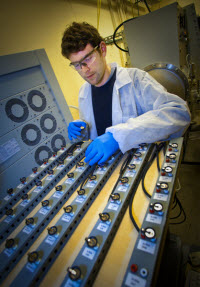CalCharge aims to foster development of tomorrow’s batteries today
 Batteries have been around since good ole Ben Franklin coined the term back in 1748, although some speculate that the first batteries were the ‘Baghdad Batteries’ which date back to 200 BCE. They’ve played an increasingly important role over time, really gaining their place with vehicles and consumer electronics in the 1900s and their future may be even more important as they step up to provide energy storage for the electric grid and power tomorrow’s vehicles. In the future such devices may help increase the amount of solar that can be integrated into the grid cost-effectively.
Batteries have been around since good ole Ben Franklin coined the term back in 1748, although some speculate that the first batteries were the ‘Baghdad Batteries’ which date back to 200 BCE. They’ve played an increasingly important role over time, really gaining their place with vehicles and consumer electronics in the 1900s and their future may be even more important as they step up to provide energy storage for the electric grid and power tomorrow’s vehicles. In the future such devices may help increase the amount of solar that can be integrated into the grid cost-effectively.
To capitalize on the opportunity and local know-how CalCEF and the Lawrence Berkeley National Laboratory have partnered to create CalCharge, which will leverage LBL’s capabilities to bring the next generations of batteries from labs to commercialization, according to CalCEF Innovations Managing Director Paul Frankel.
“This is going to be member-driven program. There are three initial market segments, grid and transportation are two of them and a third is consumer electronics, which is now the largest,” Frankel said.
Consumer batteries ranging from camera to laptop and even car batteries will be the first focus for the group. But “A lot of product requirements are similar to electric vehicles’ needs.…In the near term the market is driven by purchases in consumer electronics. We’re building on those opportunities.” The organization will help partners enter into both the EV and grid-storage markets as those industries mature, according to Frankel.
“What we’re trying to do is provide technical resources to companies that don’t have a a lot of people and equipment…to develop services and reduce time to market,” Frankel said. Through the partnership with LBL, members gain access to certain of LBL’s testing equipment and resources in a more streamlined fashion than such startup companies would otherwise be able to. However, they will have to pay for certain additional services.
“The next step is we are actually going to pursue grants at state and federal levels,” Frankel said. “We’re hoping to have this funded mostly by participants.” Ultimately the group hopes to establish the region as an energy storage innovation hub, he said. The new group was introduced on May 30 at the Silicon Valley Energy Storage Symposium.



